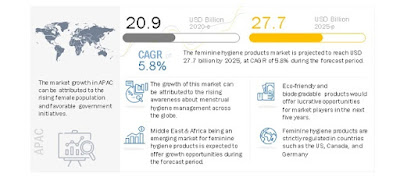Thursday, 29 July 2021
Opportunity: Developing eco-friendly feminine hygiene products
Currently, the issue of the non-biodegradability of feminine hygiene products is a serious environmental concern. However, the development of eco-friendly products such as sanitary napkins from the natural fiber is a sustainable option to advance in this market. The naturally available absorbent fibers such as organic cotton, banana fiber, jute, and bamboo etic are widely available, are biodegradable in nature, and have a low carbon footprint. The use of these fibers also reduces the manufacturing cost of sanitary napkins.
The primary function of a sanitary napkin is to absorb menstrual fluid. Hence, the selection of a core material depends on the absorbency and retention property of the fiber. Alternatives such as bamboo fiber, jute fiber, and banana fiber, along with a cellulose-based hydrogel, can provide absorbency similar to that of the synthetic superabsorbent polymer (SAP). A bio-based plastic prepared from starch also can be used as a barrier sheet in place of polyethylene and polyurethane, which are non-biodegradable in nature.
Companies such as Saathi, Carmesi, Heyday, Everteen, Purganic, and Aakar are producing sanitary napkins using 100% eco-friendly biodegradable products. Moreover, these companies enable women in rural locations to produce and distribute affordable and biodegradable sanitary napkins to the masses. This sustainable solution for developing sanitary napkins provides a unique opportunity for companies to enter the market.
The global feminine hygiene products market size is projected to grow from USD 20.9 billion in 2020 to USD 27.7 billion by 2025, at a CAGR of 5.8% during the forecast period 2020 to 2025. The market growth is driven by the rise in awareness about feminine hygiene management and the increasing disposable income of females.
To know about the assumptions considered for the study download the pdf brochure
Asia Pacific accounted for the largest share of the feminine hygiene products market in 2019. The countries considered for study in the Asia Pacific feminine hygiene products market include China, India, Japan, Indonesia, Malaysia, and Thailand. Growing disposable income, rapid urbanization, and awareness about menstrual hygiene management are driving the feminine hygiene products market in this region. Recently, the Indian government announced plans to invest USD 160 million in the Suvidha initiative, a scheme to ensure proper access to sanitary napkins in rural areas of the country. The government plans to provide biodegradable sanitary napkins to the masses at the cost of USD0.00014 through this scheme. The government plans to involve high net worth individuals (HNIs) and corporates to assist in distributing sanitary napkins to underprivileged women across the country. These developments will further boost the demand for feminine hygiene products.
Johnson & Johnson (US), Procter & Gamble (US), Kimberly-Clark (US), Essity Aktiebolag (publ) (Sweden), Kao Corporation (Japan), Daio Paper Corporation (Japan), Unicharm Corporation (Japan), Ontex (Belgium), Hengan International Group Company Ltd. (China), and Drylock Technologies (Belgium) are some of the leading players operating in the feminine hygiene products market. These players have adopted the strategies of acquisitions, expansion, and product launches to enhance their position in the market.
Don’t miss out on business opportunities in Feminine Hygiene Products Market. Speak to our analyst and gain crucial industry insights that will help your business grow.
Subscribe to:
Post Comments (Atom)
Non-Biodegradable Plastics to Lead Bioplastics & Biopolymers Market During Forecast Period
In recent years, there has been a growing awareness that the use of non-biodegradable plastics is leading to large amounts of plastic waste ...

-
The global polylactic acid market is projected to reach $43.7 billion by 2024, growing at a CAGR of 5.2% from 2018. The industry is charact...
-
The global propylene glycol market was valued at USD 3.47 Billion in 2016, and is projected to grow at a CAGR of 5.8%, to reach USD 4.60 ...
-
In recent years, there has been a growing awareness that the use of non-biodegradable plastics is leading to large amounts of plastic waste ...




No comments:
Post a Comment